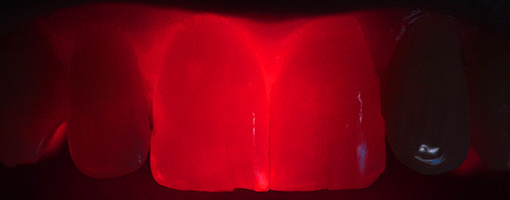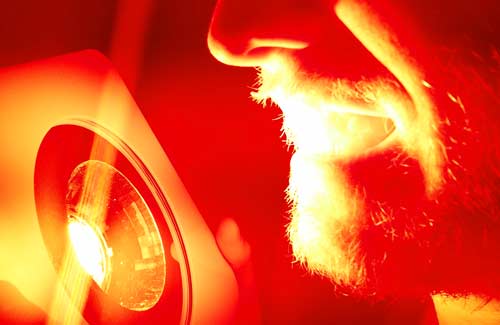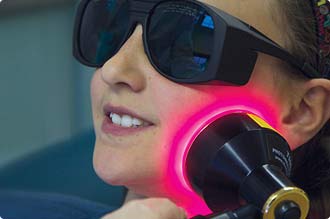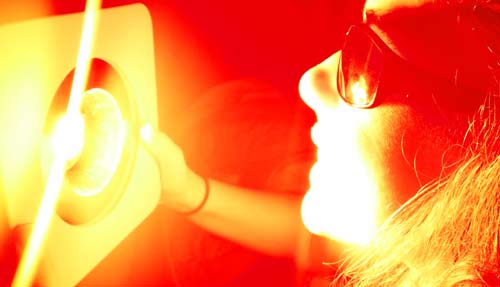Oral/Mouth Light Therapy

Red light can help with a variety of tooth and mouth problems
The quality of the studies in this field vary, from preliminary trials to double blind placebo-controlled studies. Despite this breadth of scientific research and the widespread clinical use, at-home light therapy for oral issues is not yet pervasive, for a variety of reasons. Should people start doing oral light therapy at home?Medical & Healthcare Disclaimer
The information contained in this article is not intended or implicitly suggested to be an alternative for professional diagnoses, or profesionally recommended treatments & medical advice. Absolutely all of the content, including the article text itself, images, comments and other information, contained on this web page is for non-specific information purposes only. We strongly suggest that one should never ignore professional health/medical advice and we strongly suggest that one must not delay seeking a professionally recommended medical treatment because of information attained via reading this article/website. The products sold or recommended on this web site are absolutely not for the diagnosis, prevention, monitoring, treatment or alleviation of any specific disease, injury or disability.
Teeth conditions that benefit
Studies look at various oral issues, including but not limited to:- * Sensitive teeth (dentin hypersensitivity)[8-12]
- * Tooth[1-7] & bone damage[18-24]
- * Bacteria counts (tooth decay causing bacteria)[13-17]
- * Oral thrush/candidiasis[14, 36, 42]
- * Orthodontic teeth movement[28-33]
- * Gum inflammation & oral wounds in soft tissue[25-27]
- * Recovery from surgery (gums and jaw bones)[19, 24, 25, 29]
- * Ulcers, cold sores, tonsillitis, other viral/bacterial infections[5, 14, 27, 36-38]
Oral hygiene: is red light therapy comparable with toothbrushing?
One of the more surprising findings from examining the literature is that light therapy at specific wavelengths reduces oral bacteria counts and biofilms. In some, but not all, cases to a greater extent than regular tooth-brushing/mouthwash [13,14]. The studies done in this area are generally focused on the bacteria most commonly implicated in tooth decay / cavities (Streptococci, Lactobacilli)[14-15] and tooth infections (enterococci – a species of bacteria linked to abscesses, root canal infections and others)[16-17]. Red light (or infrared, 600-1000nm range) even seems to help with white or coated tongue problems, which can be caused by several things including yeast[42] and bacteria. While the bacterial studies in this area are still preliminary, the evidence is interesting. Studies in other areas of the body also point to this function of red light in preventing infections. Is it time to add red light therapy to your oral hygiene routine?Tooth sensitivity: can red light help?

Teeth can be treated directly with a source of red light
Having a sensitive tooth is stressful and directly reduces quality of life – the afflicted person is no longer able to enjoy things like ice cream & coffee. Even just breathing through the mouth can cause pain. Most people afflicted have cold sensitivity, but a minority have hot sensitivity which is usually more serious. There are dozens of studies on treating sensitive teeth (a.k.a. dentin hypersensitivity) with red and infrared light, with interesting results[8-12]. The reason researchers were originally interested in this is because unlike the enamel layer of teeth, the dentin layer actually regenerates throughout life via a process called dentinogenesis. Some believe that red light has potential to improve both the speed and effectiveness of this process, working to improve metabolism in odontoblasts – the cells in teeth responsible for dentinogenesis. Assuming there is no filling or foreign object that may block or hamper dentin production, red light treatment is something interesting to look into in your battle with sensitive teeth.Toothache: red light comparable to regular painkillers?
Red light therapy is well studied for pain problems. This is true for teeth, just as much as anywhere else in the body. In fact, dentists use low level lasers in clinics for this exact purpose[26]. The proponents claim that the light doesn’t just help with the symptoms of pain[31, 39], saying that it actually helps on various levels to treat the cause (as already mentioned – potentially killing bacteria & rebuilding teeth, etc.).Dental Braces: oral light therapy useful?
The vast majority of total studies in the oral light therapy field focus on orthodontics. It’s no surprise that researchers are interested in this, because there is evidence that tooth movement speed in people with braces can potentially increase when red light is applied[28-30, 32-33]. This means that by using an appropriate light therapy device, you might be able to get rid of your braces much sooner and get back to enjoying food and life. As mentioned above, red light from an appropriate device might help to reduce pain, which is the most significant and common side effect of orthodontic treatment. Pretty much everyone who wears braces has moderate to severe pain in their mouth, on an almost daily basis. This can negatively affect which foods they are prepared to eat and can cause dependance on traditional painkillers such as ibuprofen and paracetamol. Light therapy is an interesting and not commonly thought of idea to potentially help with the pain from braces[31].Teeth, gum and bone damage: better chance of healing with red light?

THOR© laser being used for oral issues (image copyright – THOR Photomedicine Ltd)
Damage to teeth, gums, ligaments and bones supporting them, can happen for a variety of reasons, including natural decay, physical trauma, gum disease & implant surgery. We’ve talked above about red light potentially healing the dentin layer of teeth but it has also shown promise for these other areas of the mouth. Several studies look at whether red light can speed up healing of wounds and reduce inflammation in the gums[25-27]. Some studies even look at the potential to strengthen the periodontal bones without the need for surgery. In fact, red and infrared light are both well studied elsewhere on the body for the purpose of improving bone density (by supposedly interacting with osteoblast cells – the cells responsible for bone synthesis)[18-24]. The leading hypothesis explaining light therapy states that it ultimately leads to higher cellular ATP levels, allowing osteoblasts to perform their specialised primary functions (of building a collagen matrix and filling it with bone mineral).How does red light work in the body?
It might seem strange that light therapy is studied for practically all oral health problems, if you don’t know the mechanism. Red and near infrared light are thought to act primarily on the mitochondria of cells, leading to greater energy (ATP) production. Any cell that has mitochondria will, in theory, see some benefit from appropriate light therapy. Energy production is fundamental to life and to the structure/function of cells. Specifically, red light photodissociates nitric oxide from the cytochrome c oxidase metabolism molecules within mitochondria. Nitric oxide is a ‘stress hormone’ in that it limits energy production – red light negates this effect. There are other levels on which red light is thought to work, such as by perhaps improving the surface tension of cell’s cytoplasm, releasing small amounts of reactive oxygen species (ROS), etc., but the primary one is increasing ATP production via nitric oxide inhibition.The ideal light for oral light therapy?

Red light therapy – can it clean teeth?
Various wavelengths are shown to be effective, including 630nm, 685nm, 810nm, 830nm, etc. Several studies compare lasers to LEDs, which show equal[40-41] (and in some cases superior[16]) results for oral health. LEDs are much cheaper, being affordable for at-home use. The key requirement for oral light therapy is the ability of the light to penetrate the cheek tissue, and then to also penetrate the gums, enamel and bones. Skin and surace tissue blocks 90-95% of incoming light. Stronger sources of light are therefore necessary with regard to LEDs. Weaker light devices would only have an effect on surface issues; unable to eliminate deeper infections, treat gums, bones and harder to reach molar teeth. If the light can penetrate the palm of your hand to some extent it will be suitable to penetrate your cheeks. Infrared light penetrates to a slightly greater depth than red light, although the power of the light is always the primary factor in penetration. It would therefore seem appropriate to use red/infrared LED light from a concentrated source (50 – 200mW/cm² or more power density). Lower power devices can be used, but the effective application time would be exponentially higher.Bottom line
* Red or infrared light is studied for various parts of the tooth and gum, and regarding bacteria counts.- * The relevant wavelengths are 600-1000nm.
- * LEDs and lasers are proven in studies.
References:
Tooth regeneration:
- Pubmed ID: PMC4113395 – Photoactivation of Endogenous Latent Transforming Growth Factor–β1 Directs Dental Stem Cell Differentiation for Regeneration
- Pubmed ID: 9409045 – The current status of low level laser therapy in dentistry. Part 2. Hard tissue applications.
- Pubmed ID: PMC3601343 – Periodontal Bone Regeneration and the Er,Cr:YSGG Laser: A Case Report
- Pubmed ID: 15478483 – Argon laser irradiation and fluoride treatment effects on caries-like enamel lesion formation in primary teeth: an in vitro study.
- Pubmed ID: 25240388 – Low-level laser therapy as an alternative for pulpotomy in human primary teeth.
- Pubmed ID: 24974864 – Clinical and radiographic outcomes of the use of Low-Level Laser Therapy in vital pulp of primary teeth.
- Pubmed ID: 24858234 – The effect of low-level laser therapy (810 nm) on root development of immature permanent teeth in dogs.
Sensitive teeth:
- Gerschman J A et al. Low Level Laser in dentine hypersensitivity. Australian Dent J. 1994; 39: 6.
- Pubmed ID: 20589404 – Low-level laser therapy of dentin hypersensitivity: a short-term clinical trial.
- Pubmed ID: 24197517 – Clinical evaluation of low-power laser and a desensitizing agent on dentin hypersensitivity.
- Pubmed ID: 20863237 – Effects of the combined desensitizing dentifrice and diode laser therapy in the treatment of desensitization of teeth with gingival recession.
- Pubmed ID: 19281413 – Clinical evaluation of Nd:YAG and 685-nm diode laser therapy for desensitization of teeth with gingival recession.
Mouth bacteria:
- Pubmed ID: 2145417 – Comparative effects of toothpaste brushing and toothpaste rinsing on salivary bacterial counts.
- Pubmed ID: 22189647 – In Vitro effect of low-level laser therapy on typical oral microbial biofilms.
- Susceptibility of Streptococcus mutans biofilms to photodynamic therapy: an in vitro study – Iriana Carla Junqueira Zanin et al.
- Pubmed ID: 26241781 – A Comparison of the antibacterial activity of the two methods of photodynamic therapy (using diode laser 810nm and LED lamp 630nm) against Enterococcus Faecalis in extracted human anterior teeth.
- Pubmed ID: 21787505 – Evaluation of photodynamic therapy using a light-emitting diode lamp against Enterococcus faecalis in extracted human teeth.
Bone:
- Pubmed ID: 25653816 – Effect of low level laser therapy on proliferation and differentiation of the cells contributing in bone regeneration.
- Pubmed ID: 26511218 – Bone healing after low-level laser application in extraction sockets grafted with allograft material and covered with a resorbable collagen dressing: a pilot histological evaluation.
- Pubmed ID: 14651794 – Effects of pulse frequency of low-level laser therapy (LLLT) on bone nodule formation in rat calvarial cells.
- Pubmed ID: 22138375 – Low level laser therapy (830nm) improves bone repair in osteoporotic rats: similar outcomes at two different dosages.
- Pubmed ID: 20204601 – Laser 904 nm action on bone repair in rats with osteoporosis.
- Pubmed ID: 26037661 – Low-level laser therapy improves bone formation: stereology findings for osteoporosis in rat model.
- Pubmed ID: 16503787 – Laser therapy improves healing of bone defects submitted to autologous bone graft.
Oral wound healing:
- Pubmed ID: 25867988 – Periodontal and peri-implant wound healing following laser therapy.
- Pubmed ID: 24656472 – Developments in low level light therapy (LLLT) for dentistry.
- Pubmed ID: PMC3977514 – Use of Low Level Laser Therapy for Oral Lichen Planus: Report of Two Cases
Orthodontic:
- Pubmed ID: 22350425 – Effect of low-level laser therapy (LLLT) on orthodontic tooth movement
- Pubmed ID: PMC3955317 – Effects of low-level laser therapy on orthodontic tooth movement and root resorption after artificial socket preservation
- Pubmed ID: PMC4264099 – Effect of Low Level Laser Therapy on Orthodontic Tooth Movement: A Review Article
- Pubmed ID: 22775467 – Efficiency of low-level laser therapy in reducing pain induced by orthodontic forces.
- Pubmed ID: 19840281/ – Low-energy laser irradiation accelerates the velocity of tooth movement via stimulation of the alveolar bone remodeling.
- Pubmed ID: 23883115 – Influence of low-level laser therapy on the rate of orthodontic movement: a literature review.
General
- Tunér J, Hode L. Low level laser therapy – clinical practice and scientific background. ISBN 91-630-7616-0.
- Tunér J, Hode L. It´s all in the parameters: a critical analysis of some well-known negative studies on low-level laser therapy. Journal of Clinical Laser Medicine & Surgery. 16 (5): 245-248.
- Pubmed ID: 15954824 – Effect of low-level laser therapy on Candida albicans growth in patients with denture stomatitis.
- Pubmed ID: PMC3972568 – Efficacy of Low-Level Laser Therapy in Treatment of Recurrent Aphthous Ulcers – A Sham Controlled, Split Mouth Follow Up Study
- Pubmed ID: 19161055 – Low-level-laser therapy as an alternative treatment for primary herpes simplex infection: a case report.
- Low level laser therapy (LLLT) for orofacial pain – Seyyedi et al
- Laser Ther. 2011; 20(3): 205–215. Is light-emitting diode (LED) phototherapy really effective? Won-Serk Kim and R Glen Calderhead
- An Bras Dermatol. 2014 Jul-Aug;89(4):616-23. Effects of low-power light therapy on wound healing: LASER x LED. Chaves ME et al., 2014
- Pubmed ID: 11862203 – Treatment of oral candidiasis with methylene blue-mediated photodynamic therapy in an immunodeficient murine model.
